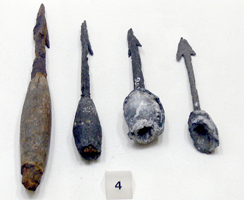
This page created 1 August 2014, and last modified: 30 October 2014 (Frankfurt fragment image added)

In the western half of the empire, the Honoriani Gallicani is listed as one of auxilia palatina units in the Magister Peditum's infantry roster; it is apparently assigned to the Comes Illyricum under the title Mattiarii Honoriani Gallicani. Its shield pattern as shown in various manuscripts is as below:

The shield pattern is simple, with a main white ground and an indigo boss (faded to pink in M, W, and Ff); each is bordered with a red rim. As a result, the pattern is similar to a number of others in the Notitia, such as those ascribed to the Celtae iuniores and the Salii Gallicani.
The name Victores means "victorious", a common epithet for a Roman military unit, although is is also particularly associated with Constantine I, who adopted the name "Victor" after defeating Licinius, in place of his former usage of "Invictus" (see Constantine: Roman Emperor, Christian Victor; Paul Stephenson, 2009, page 216), after publicly espousing Christianity in place of the worship of Sol Invictus; "invicti" is another common military epithet found in the Notitia.
The name Mattiarii seems to be indirectly linked to the god Mars via the word mattiobarbuli - the lead-weighted throwing darts (Vegetius 1.17) with which infantrymen were equipped. These were also known as plumbatae, from their lead weights, and as martiobarbuli; the latter meaning "Mars' little barbs".

Several other units in the Notitia bear the name "Ma(t)tiarii":
Matiarii seniores, the highest-ranked unit of legiones palatina under the Magister Militum Praesentalis IIAs all of these are legionary units, and being highly-ranked, appear to have been long established as field units. This contrasts with the Honoriani Gallicani, which is both an auxiliary unit, and although a palatine unit, is the lowest-ranked of the (confirmed) auxilia palatina units under the Comes Illyricum.
Matiarii iuniores, a unit of legiones palatina under the Magister Militum Praesentalis I
Matiarii constantes, the highest-ranked unit of legiones comitaenses under the Magister Militum per Illyricum
Mattiarii iuniores, the highest-ranked unit of legiones comitaenses in the Magister Peditum's Italian command
Moreover, the Notitia also contains a number of Mattiaci units, such as:
Mattiaci seniores, a unit of auxilia palatina under the Magister Militum Praesentalis IAs these are all auxilia palatina units, it may very well be that Mattiarii Honoriani Gallicani should rather be called the Mattiaci Honoriani Gallicani. Since the Mattiaci iuniores Gallicani has no corresponding seniores unit, I might speculate further that the Honoriani Gallicani's full name might have been the Mattiaci Honoriani seniores Gallicani. The name Mattiaci is tribal; according to Tacitus in the 1st century, belonging to a German tribe that were neighbours of the Batavians. Mattiacum was a famous spa town in the area from the second century; it is now known as Wiesbaden.
Mattiaci iuniores, a unit of auxilia palatina under the Magister Militum Praesentalis II
Mattiaci seniores, a unit of auxilia palatina in the Magister Peditum's Italian command
Mattiaci iuniores, a unit of auxilia palatina in the Magister Equitum's Gallic command
Mattiaci iuniores Gallicani, another unit of auxilia palatina in the Magister Equitum's Gallic command
The name Honoriani refers to the emperor Honorius, who succeeded his father Theodosius I in 395, around the time the Notitia was first compiled. Note that Honorius had however, been declared co-Augustus two years earlier, at the age of 7, so the presence of units bearing the name Honorius does not therefore prove they must have been entered into the document so-named at 395 at the earliest. Nonetheless, the presence of large numbers of units named after Honorius in the western half of the Notitia, compared to very few in the east, is one of the clearest indications the eastern portion was not amended much, or even at all, after the death of Theodosius, while the western half was extensively updated.
The name Gallicani refers to the region of Gaul, and probably indicates the unit was either stationed somewhere there before attached to the Illyrian field army, or else that it was raised there.

Return to the Notitia alphabetical unit list page.
Return to my Notitia index page.